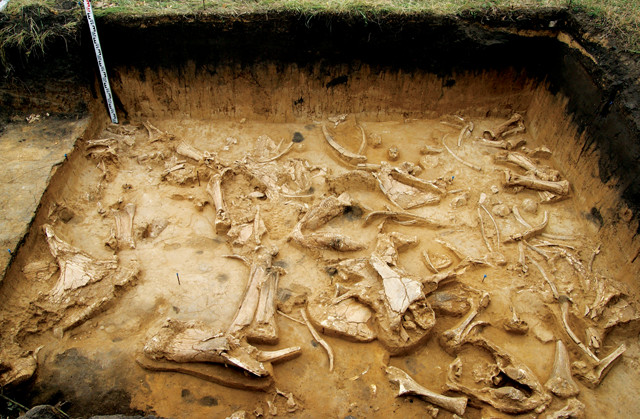
by Lucas Joel Monday, February 8, 2016

Some of the more than 23,500 mammoth bones analyzed in a new study that found the animals might have been suffering from various bone ailments prior to going extinct. Credit: Sergey Leshchinskiy.
The demise of mammoths, which went extinct by the end of the Pleistocene about 12,000 years ago, is thought to have been brought about by a combination of climate change and overhunting by early humans. A new study indicates that another culprit might have contributed as well: Mammoth bones retrieved from Northern Eurasia — from sedimentary strata close to the animals’ last known appearance in the fossil record — appear to show evidence for bone diseases associated with nutrient deficiencies.
Mammoths, like their modern-day relatives, elephants, may occasionally have acquired key nutrients by ingesting soils and rocks enriched with these nutrients. The new research, published in Archaeological and Anthropological Sciences, suggests that the emergence of nutrient-deficient landscapes at the end of the last ice age inhibited mammoths’ ability to acquire sufficient nutrients. The transformation from nutrient-rich to depleted landscapes was likely associated with the warming climate at the time, which created more acidic conditions that stripped nutrients from soils.
“The largest Northern Eurasia mammoth fossil sites are spatially related to these landscapes,” says Sergey Leshchinskiy, a paleontologist at Tomsk State University in Russia and author of the new study. Leshchinskiy examined more than 23,500 mammoth bones recovered from the Tomsk region of Siberia, among other locations, finding that “destructive changes in bones and teeth occur in [as much as about] 70 percent of all remains.”
Examples of bone damage identified include ailments well known to modern-day medicine, such as osteoporosis, which causes bones to become brittle and more breakable due to a lack of nutrients like calcium and vitamin D. Leshchinskiy also documented evidence of osteoblastomae, or tumors of the bone, as well as osteolysis, which involves destruction of preexisting bone tissue, among others.
“This study offers some very interesting speculation, and a [question] that’s worth pursuing,” says Bruce Rothschild, a rheumatologist at the University of Kansas who specializes in the paleopathology of animals like mammoths, and who was not involved in the new work. “But interpretation of the pathology of these bones is complicated,” he says. “For instance, the changes identified [by Leshchinskiy] in the ribs as signs of osteoporosis: I’m not sure what they are, but they are not the characteristic changes we would expect from the disease.”
Another challenge with a study like this, Rothschild says, is that it can be hard to determine which features in the bones are the result of taphonomy — the history of what has happened to bones between an animal’s death and when they’re found — and what is an actual pathological feature. Furthermore, in determining whether or not bone disease contributed to the mammoths’ eventual extinction, Rothschild explains that “just because an animal had a disease, that doesn’t mean that the disease killed it; and even if the disease were severe, that doesn’t mean it had a huge impact on the animal’s life span.”
Still, the idea that nutrient-deficient landscapes may have impacted mammoth health toward the end of their reign is a new one, says Jeffrey Saunders, a paleontologist at the Illinois State Museum who was also not involved in the study. “The work investigates ideas that have not really been explored before in the field,” he says. “Quaternary geologists in the United States are not looking at things this way — especially with regard to chemical landscapes — and I think it ought to be encouraged more here.”
To better characterize bone disease prevalence, the frequency of each affliction within the population of bones studied needs to be determined, Rothschild says — something that was not done in the new work. “If you take each bone phenomenon and identify its prevalence,” he says, that will help show which maladies may have been most commonplace, and, hence, which nutrients were most lacking in mammoth diets.
© 2008-2021. All rights reserved. Any copying, redistribution or retransmission of any of the contents of this service without the expressed written permission of the American Geosciences Institute is expressly prohibited. Click here for all copyright requests.